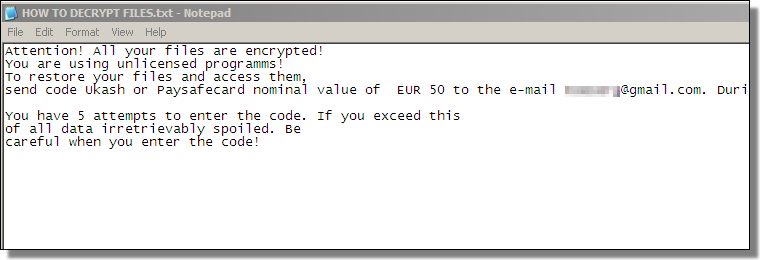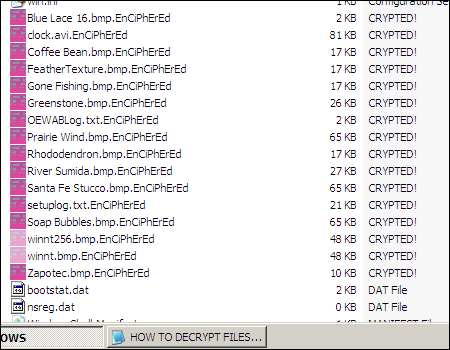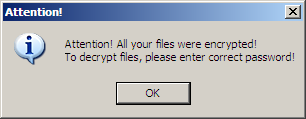Trojan:W32/Ransomcrypt
Summary
Trojan:W32/Ransomcrypt is ransomware that encrypts files on the affected computer and demands payment, supposedly to provide a password decrypting the affected files.
Removal
Based on the settings of your F-Secure security product, it will either move the file to the quarantine where it cannot spread or cause harm, or remove it.
Decryption of files
Investigations to determine if Trojan:W32/Ransomcrypt's encryption of personal files can be cracked are ongoing.
A False Positive is when a file is incorrectly detected as harmful, usually because its code or behavior resembles known harmful programs. A False Positive will usually be fixed in a subsequent database update without any action needed on your part. If you wish, you may also:
-
Check for the latest database updates
First check if your F-Secure security program is using the latest updates, then try scanning the file again.
-
Submit a sample
After checking, if you still believe the file is incorrectly detected, you can submit a sample of it for re-analysis.
Note: If the file was moved to quarantine, you need to collect the file from quarantine before you can submit it.
-
Exclude a file from further scanning
If you are certain that the file is safe and want to continue using it, you can exclude it from further scanning by the F-Secure security product.
Note: You need administrative rights to change the settings.
Technical Details
Trojan:W32/Ransomcrypt is ransomware that encrypts files on the affected computer, alledgedly because the user is "using unlicensed programms!", according to a text file note left by the malware author:

Image 1: Ransom demand made by Trojan:W32/Ransomcrypt
When first run on the system, Trojan:W32/Ransomcrypt will drop a randomly-named copy of itself in the %temp% folder; it will also iterate all folders on the system. Every document, image and shortcut file it finds will be encrypted and appended with the extension, .EnCiPhErEd:

Image 2: Files encrypted by Trojan:W32/Ransomcrypt
In each folder, the trojan will also drop a file named "HOW TO DECRYPT.TXT" (seeImage 1) that contains instructions on how to proceed with payment to remove the encryption.
Ransomcrypt will then create registry entries to associate the .EnCiPhErEd extension with itself so that the copy in %temp% will be launched whenever the encrypted files are run and demand the password to decrypt the files:

Image 3: Password prompt from Trojan:W32/Ransomcrypt
After 5 tries it will no longer accept passwords. And it then deletes itself, leaving the files encrypted.
)
Protect your devices from malware with F‑Secure Total
Protecting your devices from malicious software is essential for maintaining online security. F‑Secure Total makes this easy, helping you to secure your devices in a brilliantly simple way.
- Award-winning antivirus and malware protection
- Online browsing, banking, and shopping protection
- 24/7 online identity and data breach monitoring
- Unlimited VPN service to safeguard your privacy
- Password manager with private data protection
More Support
Community
Ask questions in our Community .
User Guides
Check the user guide for instructions.
Submit a Sample
Submit a file or URL for analysis.